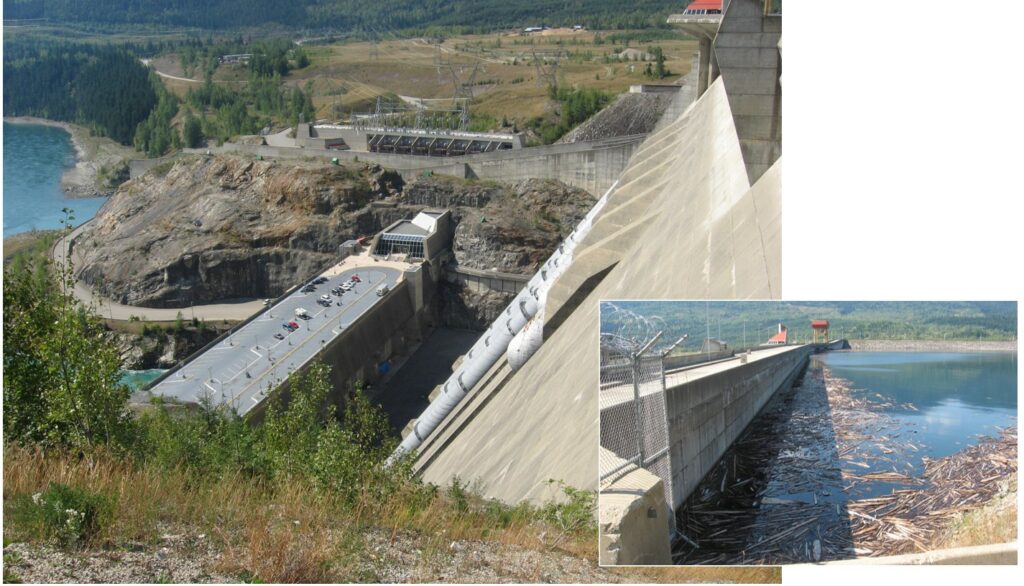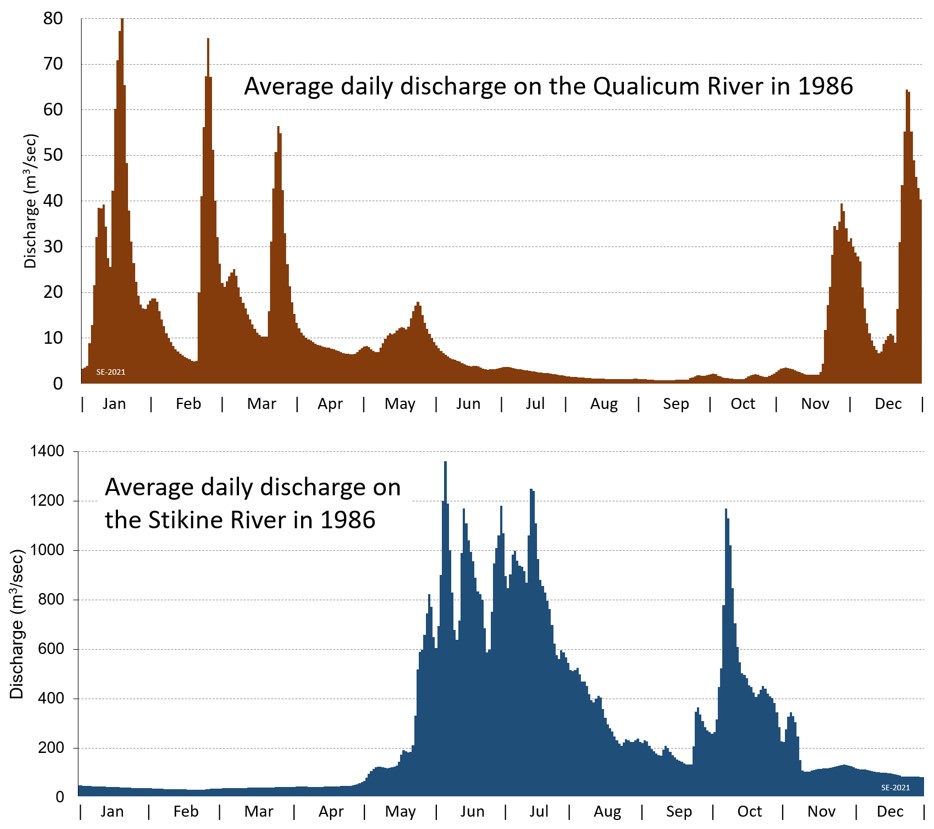9.2 Hydro
Hydro power is a product of solar energy because water, evaporated by the sun, falls onto land at elevation, and then flows down to the ocean. If we interrupt that flow, we can use its potential energy to generate electricity. Hydro power is particularly effective in areas where there has been tectonic uplift to create mountains, and where there is abundant precipitation in the form or rain or snow.
There are two main types of hydro-electric facilities, those that involve construction of dams, and those that involve diversion of part of the water of a stream into a canal and/or a pipe. We’ll refer to the first type as “dam and reservoir hydro”, and to the second type as “run-of-river hydro”.
Hydro electricity is a very mature industry that goes back to the late 19th century. It currently represents 47% of the installed global renewable energy capacity (and 6.5% of all energy capacity), but the rate of growth in hydro is now very close to 0%. Although there have been many enhancements to hydro energy technology in the past 100 years, it’s not likely that we will see significant technological advances in the future, and while there are many rivers that have still hydro potential, the public appetite for changing how rivers flow, just to generate electricity, is waning.
Dam and Reservoir Hydro
Most large hydro projects involve construction of a dam across a river and the creation of a reservoir behind that dam. The difference in elevation between the surface of the reservoir and that of the river below the dam is the hydraulic head, and the amount of energy that can be generated is proportional to that difference and to the rate at which water can flow through the turbines. An example is the Revelstoke Dam on the Columbia River in British Columbia (Figure 9.2.1). The Revelstoke Dam is 175 m high. It has created a reservoir (Lake Revelstoke) that is 130 km long and has flooded just over 100 km2 of land. The electricity production capacity at Revelstoke Dam is 2,480 MW.
The significant value of a dam and reservoir is that a lot of water is stored (except under long-term drought conditions), and that water can be used to generate electricity according to the demand. The rate of flow through the turbines can be slowed (or even stopped) during the night (or over the summer) when demand is low and increased in the daytime (or during the winter) when the demand is higher. This type of production flexibility is especially valuable in areas where there is a significant proportion of non-dispatchable electricity generation from sources like solar and wind.

Two significant disadvantages of dam and reservoir hydro are that they block passage of migratory fish, and that they result in the flooding of large areas of land that was useful for other purposes or for nature. It’s true that fish ladders can be constructed, but they are not typically successful in the case of a high dam like the one at Revelstoke. Flooding of land is inevitable when dams are constructed, and the implications of that include:
- loss of human habitat (e.g., construction of the Three Gorges Dam in China, the world’s single largest hydro project, resulted in relocation of 1.24 million residents from 13 cities, 140 towns and 1350 villages),
- loss of farmland (which is a big issue for the Site C dam under construction in British Columbia),
- loss of natural terrestrial and aquatic (river) habitat,
- increased risk of slope failure and bank erosion (see Section 5.2 in relation to the Revelstoke Dam and the Downie Slide),
- potential for release of mercury naturally present in soils[1], and
- potential for release of carbon dioxide from breakdown of organic matter (this is most likely to be an issue in tropical areas and where the reservoir is shallow).
Run-of-River Hydro
A run-of-river hydro installation is illustrated on Figure 9.2.2. Sechelt Creek flows into a coastal inlet about 60 km northwest of Vancouver. The three parts of the project are the head pond, at an elevation of 360 m, where a weir has been built to ensure that the upper end of the penstock is always submerged. Water flows from there through a 4-km long 1.2 m diameter steel pipe (penstock) to the powerhouse, where it is used to turn either one or both of two 8 MW turbine generators. This project did not involve flooding any land (the head pond is entirely within the river’s normal channel) and it has not disrupted the passage or habitat of migratory fish. (A waterfall just upstream from the powerhouse has always prevented ocean fish from migrating to the middle and upper parts of Sechelt Creek.)

Water is not stored in a reservoir in the case of run-of-river hydro, instead the generation of electricity is dependent on the discharge of water at any one time. Over the course of a year the discharge of a stream like Sechelt Creek can vary significantly from season to season and even from day to day.
Two examples of river discharge variations are provided on Figure 9.2.3. The Qualicum River is situated in a coastal area of Vancouver Island where although the surrounding mountains are frozen and snow-covered over the winter, the lowland areas tend to remain unfrozen and rain is common. The hydrograph is dominated by rainfall in the fall, winter and early spring months, and very little precipitation from June through later September. The Stikine River drains a region in northern BC in a mountainous area that remains frozen through the winter and there is almost no melting between December and April. The hydrograph is characterized by very low flows during the cold months, and very strong snow-melt and rain-driven flows in the spring, summer and early fall.

The significant differences in the flow patterns of the Qualicum and Stikine Rivers illustrates the importance of understanding supply and demand when it comes to run-of-river generation. Sechelt Creek has a hydrograph similar to that of the Qualicum River, and so it can typically generate electricity at peak power in the period from November through June, but produces little or no power over the summer months. This fits well with the electrical power demand in British Columbia, which is greatest in winter, but a river like the Stikine would not be very suitable for run-of-river generation in British Columbia because it has relatively little flow in the winter months.
Exercise 9.3 Power and Energy
When you turn on a tap or crank a pump handle the water flows out a certain rate (the flow rate) and if you let it flow for a while you’ll have some water in a container (a volume). The electrical equivalents of flow rate and volume are power and energy, and as described in Box 9.1, we can express those as watts and watt hours. This is confusing because we are used to expressing rates using terms like litres/minute, or kilometres/hour, but a watt is already a rate (in fact it is 1 joule/second). To get the amount of energy used or produced we need to multiply the rate by time. A watt-hour (Wh) is a unit of energy, and it the amount used when a 1 W led bulb is on for 1 hour, or how much is produced when a 300 W solar panel is placed in direct sunlight for 12 seconds (1/300th of an hour).
Here are some practice questions to help you get this straight.
- Which of these amounts might be appropriate to express the amount of energy stored in an electric car battery:
a) 100 km/h, b) 50 kW, c) 5 kWh, or d) 600 km? - Which term might be appropriate to express the capacity of a hydro-electric project:
a) 500 MW, b) 75 KWh, c) 5000 L/s, or d) 75 kW/h? - Which term might be used to describe an LED lightbulb:
a) 10 Wh, b) 20 W/hour, c) 8 W, or d) 20 lumens/h - What would be an appropriate term to express the amount of energy used by an electric bike:
a) 20 km/h, b) 10 Wh/km, c) 300 W, or d) 50 kWh
Exercise answers are provided Appendix 2
Media Attributions
- Figure 9.2.1 Steven Earle, CC BY 4.0
- Figure 9.2.2 Photos by Steven Earle, CC BY 4.0
- Figure 9.2.3 Steven Earle, CC BY 4.0, based on public domain data at Water Survey of Canada, Environment Canada, https://wateroffice.ec.gc.ca/
- Small amounts of mercury are naturally present in an oxidized form in soil. When an area is flooded the resulting less-oxidizing conditions at the bottom of the reservoir promote the conversion of some of that mercury to a soluble form which then gets into the water and is dispersed downstream. This mercury has health implications for aquatic species, and also for those who depend on aquatic species (especially fish) as a food source. ↵
